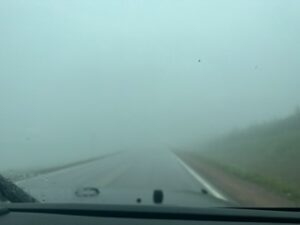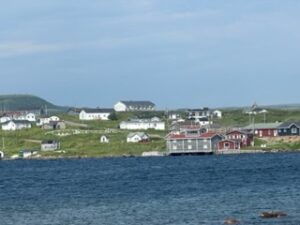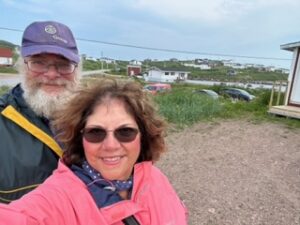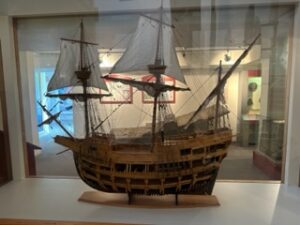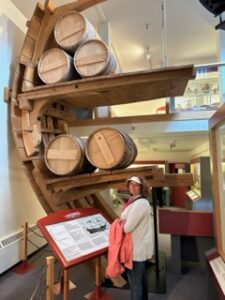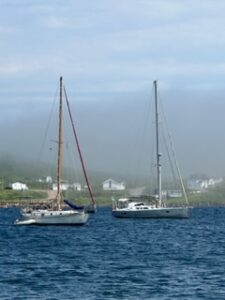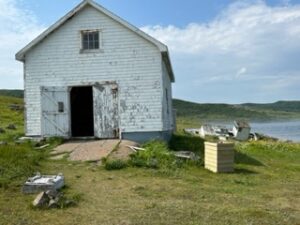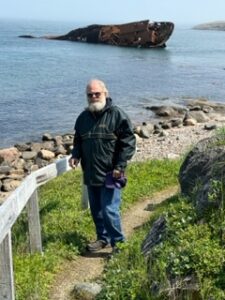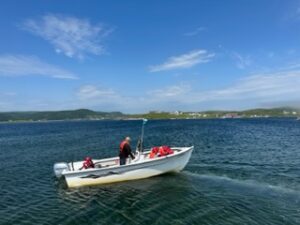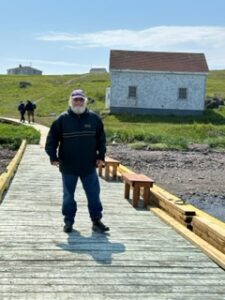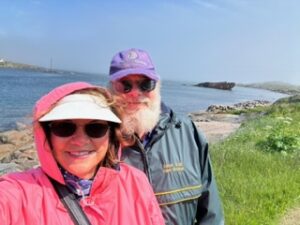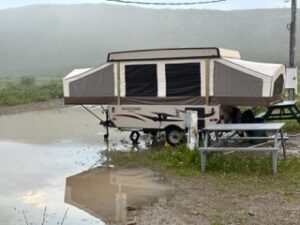Tuesday, July 25 was a travel day to the ferry for Labrador, sailing out of St. Barbe, NL. We got there early, which was good as we had heard that sometimes people are left off the ferry if it is too full, even if they had a reservation. We had one tense event when the loader noticed we’d been overcharged. Mary was able to go back and wait in line for 20 minutes to get the $8 refund. Bankruptcy averted. Luckily we boarded as scheduled for the under 3-hour sail to Blanc Sablon, Quebec, a few kilometers west of the Labrador border, and it was smooth sailing. It was a short drive from the port to L’Anse au Clair where our campground was located in the “heart of town” – which is true, but the town is only a few blocks long.
We easily found the Northern Lights Hotel, which also owns the campground. The campground was across the road in what looked like an industrial park. Turning into the driveway and upon second viewing the warehouse-looking building was actually concrete cottages or apartments. Behind that building was a second one with toilets, showers and laundry. The campground had about 9 sites on the right, but they seemed short and had wooden fences between the sites. There were 10 pull-through sites to the left and we decided to take one of those, close to the toilets which is Mary’s preference. The campground seemed much more like a parking lot with power and water hookups. The first of the sites to our right as we entered had a dump truck parked there that had been there long enough to have tall grass growing around it and contributing to the look of a parking lot. The only other camper was down in the last slot on the right, a full-size unit, 26’ or so. It looked like there were 2 occupants that work at the hotel or one of the local businesses across the road from the hotel. There really wasn’t another option so we camped there.
Mary had been eaten alive in the Quirpon area and did not want to go outside unless absolutely necessary. As soon as we got out of the car the bugs started having dinner on her neck. It’s the norm in Labrador and Western Newfoundland. If you say something to the locals they shrug their shoulders, tell you it’s what they live with, and show you their scars. They may also give you warning of what to expect in their area (I.e. BIG biting flies). Even Scot got bitten which hitherto was unheard of. A stiff wind can make the bugs less annoying which, thankfully, there was the next few days.
A couple we had seen on the ferry, Winston and VJ, pulled in and set up for the night and we introduced ourselves. Our conversation with Winston and VJ was short. An hour or so later we hear sirens in the distance, getting gradually closer to “town” like the emergency vehicles were going 20 mph. After 5+ minutes the sirens now sounded like they were just behind the hill of the road, out of sight from where we were standing. Over the hill and down into the “upper town” comes a fire/rescue vehicle moving at ‘parade’ speed (that is to say a 20 mph crawl, sirens blaring, lights strobing away, followed by 3-4 pickup trucks with lights flashing and Canada flag raised high and flapping in the wind. This procession went on for 5 minutes at least, fire trucks, ambulances and rescue vehicles interspersed between the cars and trucks. The procession had to be 40 or so cars/trucks long. It descended the hill and at the bottom took the first left. That led to another left and the lead rescue truck of the procession coming back to main street on a side road at the top of the hill, where it had to wait a couple minutes for the last procession vehicles to pass by. The procession took a left onto main street and followed the same route again, except at the bottom of the hill they stayed on main street a little further and pulled off to the left and into the lower town, the waterfront and drove around there twice before emerging and coming back up the hill, the last rescue truck killing it’s sirens and lights as it passed the crest of the hill leading out of town and out our sight.
VJ came over to inform us that a local woman, Alyson Thomas of L’Anse au Clair, is a Canadian Olympic-class athlete that just won for Gold in the ISBHF World Junior Championships in Ball Hockey (Google it). The parade was in honor of her. By this time Mary was being circled by bugs like sharks in bloody waters and she had to retreat into the camper, and I followed. We weren’t able to get out again that night to talk more with Winston and VJ. We retired as it started to rain.
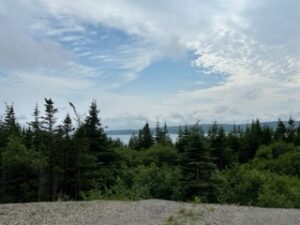
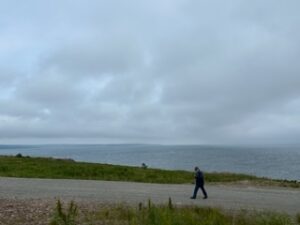
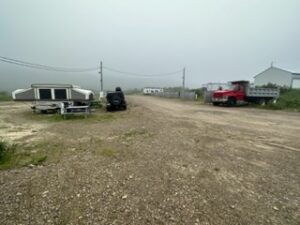
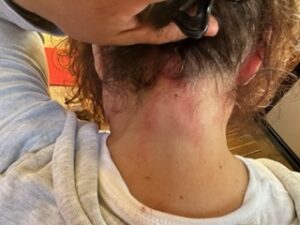
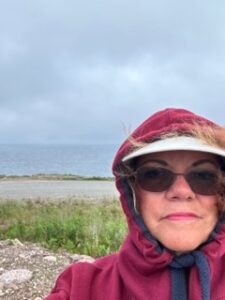
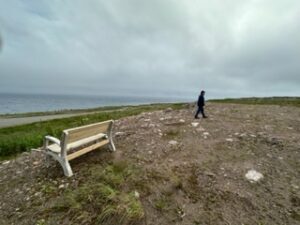
Wednesday we woke to rain that tailed off quickly, leaving things damp and foggy. The thick fog obscured vision beyond 100-200 yards in any direction from our campsite. We struck out to visit the little towns/villages along the Trans-Labrador highway from it’s start here in L’Anse au Clair, where we were staying, after a quick chore. The Jeep needed an oil change, and we found a place in Forteau about 9km away, that was our first stop that day. It took longer than expected, unforeseen consequences of being in a small town, and 90 minutes later we were back in action.
The next town was L’Anse Amour and the Point Amour Lighthouse and Provincial Historic site; there was also a National Historic site there. L’anse Amour is the second tallest lighthouse in North America. The lighthouse was a rare circular, stone structure with the usual keeper’s house and other outbuildings, all attached to each other. This meant the lighthouse keeper had to spend no time in an area unprotected by cover when traveling between buildings. We were able to climb the 137 steps to the top of the tower, to the light chamber, which is always the goal of a lighthouse visit. There’s a museum attached to the lighthouse as well with very detailed dioramas of the lighthouse’s construction and history. This LH had to be built tough to withstand the 200km/h winds that frequently batter the LH during the storm seasons of Spring and Fall.
We kept on towards the next town, L’Anse au Loup, which is a good place for iceberg spotting, and we saw several good-sized bergs there. We went as far as Pinware River Provincial Park a couple towns north of L’Anse au Loup for some hiking. The trails were wet, soggy, muddy and we did not go far. The bugs all came out in the later afternoon and decided we were much tastier than their normal diet and the BrowningSmith buffet was open for business. We took our “food trucks” elsewhere. Pinware is not a large park but does have coastal access and a number of nice trails to hike that run to the ocean and along the coast. The campsites were beautiful, with private, wooded sites. Unfortunately, they don’t have services – electric, water, sewage – so we weren’t able to move to a new home.
We returned to our campsite and noticed no fire pits so we inquired at the registration desk and no one could tell us if (a)there are firepits available, (b) if campfires are even allowed at the sites, or (c) if there was anyone who would know and could be asked for a definitive answer. It’s almost like they were disgruntled employees with no incentive or enthusiasm for going out of their way to help a guest with a question. I took their apathy as liberty to proceed with my building a fire. Since we were camping in a “parking lot” there were plenty of rocks around, I built a fire ring and loaded it up with wood and got a fire started. My wood is soft wood, pine and birch, and it smokes. Soon there was a smokey plume rising into the sky and of course the rain began to fall, slowly but with increasing speed. The smoke worried me as I didn’t want the cops or fire departments to come looking for its source and the sudden onset of rain helped me decide the issue. I put out by budding fire. Then the bugs started up again, the vicious little bastards know no mercy! Mary can’t be out in that kind of swarming activity, the rain would not cease, just slowly tapering off then starting again, tapering off, etc. There would be no fire tonight.
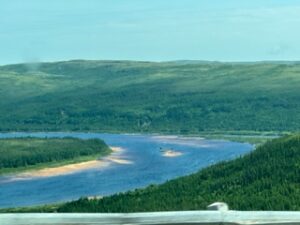
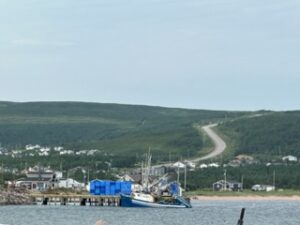
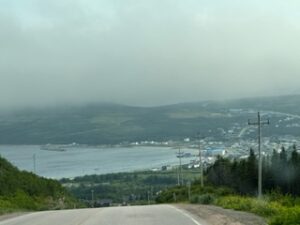
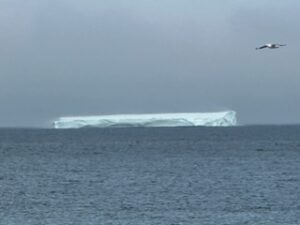
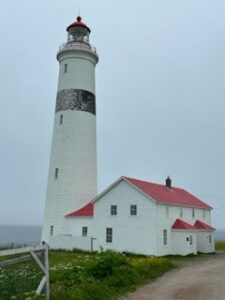
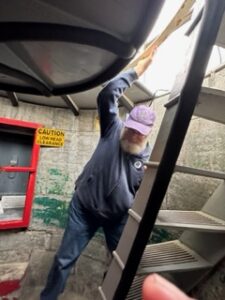
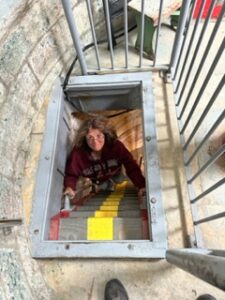
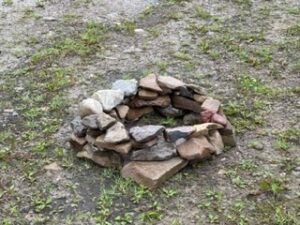
Thursday we woke to thick fog, we could barely see the front of the hotel across the street 100 yards away, and it was not dissipating quickly. By 11 AM we decided to head out and hope the fog would lessen or blow away as we gain distance from L’Anse au Clair, which we did after 8-10 miles. Driving through the fog was a bit harrowing, being on a 2-lane road, with numerous potholes, twisty, windy, switch-backed road, a sheer drop to the ocean on one side and a steep embankment on the other, it was slow going for the first several miles until the road angled more inland after Pinware. The scenery along the drive when we could finally see it was amazing. The usual accompanying rain showed up as the fog abated but it was light and did not reach us in Red Bay, nor deter us from our day there.
We visited the Red Bay National Historic Site which told the story of the Basque fishermen from the NE of Spain and the SW of France, that came to the Labrador coast starting around 1530, to hunt whales for oil and baleen. They used the sheltered harbor of Red Bay for their seasonal base for processing whale oil primarily. They plied these waters of the Strait of Belle Isle for about 70 years before the whale population in the area declined and they moved on to other locations in the early 16th century. It was not known until the 1970’s when a determined woman named Selma Barkham researched the coming of the Basque to Labrador using archival records in Canada, Spain and Basque enclaves in Spain that led to the discovery of the remains of a whaling station in Red Bay in 1977.
Since then, archaeological teams have found four 16th century whaling vessels and several smaller boats used by whalers at the bottom of the harbor. One of the galleons was excavated, studied extensively, and reburied in its resting place in the harbor along with a chalupa, a type of vessel used by whalers to hunt and kill whales. It was studied for 13 years and reassembled and on display in the Red Bay Visitor Orientation Center. We saw recreations of the ships used for such expeditions, hauling the oil and baleen back to the whaler’s home countries to get rich from the profits.
There was also a Whaling Museum at the Town Hall associated with the Visitor’s Center and Red Bay’s history. They have a full-size bowhead whale as well as a wealth of information such athe whale most hunted wither – Right Whales, called “right’ whales because they were the right kind to hunt, slow and easy to catch, and very blubbery, which meant more oil from their fat than in other whale types.
We took a speed boat out to Saddle Island in the mouth of the bay, once a fortified defensive position, now it is a park with a few kilometers of trails, much of it a plank boardwalk with stairs, to help preserve the native plants life. We saw a wreck of a cargo ship from the early 20th century sticking up out of the water thanks to heavy weather over the last several years that washed it up off the bottom of the bay on to some shoals and here it still lies, rusting away to nothingness, returning to the sea. After we got back to shore, we took a hike on the Boney Shore trail to a beach littered with whale bones and pieces from the 16th century whaling operations, a whale graveyard, but we took a wrong turn on the path and did not reach the bone yard. We tried to find the right path, but the clouds were beginning to darken, and the fog was rolling back in, and we decided to head back to L’Anse au Clair now, while it was still daylight, rather than make another harrowing drive in the fog to the campsite.
We got back with it raining at a moderate, steady pace but within the hour the heavens let loose with a fury – a violent storm assailed us. The storm sounded very, very loud as it beat down on the camper roof and canvas sides, the thunder cracked overhead so loud it shook the camper several times. I made an audio recording I’ll try to share it with you. The storm ended a few hours later that night, after 3 more camper-shaking bursts of severe activity. The area around the front of our site was flooded, reaching up to the front leveler jacks of the camper; we were level in the camper but the ground we were on sloped from E to W, west being the front of the camper, and the water pooled there and to the southside also, but there was no one camping there. The water had mostly receded by morning, so we were able to put away only damp, not soaking wet.
